Specialist homelessness services client pathways: Clients supported in 2018–19
Citation
AIHW
Australian Institute of Health and Welfare (2023) Specialist homelessness services client pathways: Clients supported in 2018–19, AIHW, Australian Government, accessed 27 April 2024.
APA
Australian Institute of Health and Welfare. (2023). Specialist homelessness services client pathways: Clients supported in 2018–19. Retrieved from https://pp.aihw.gov.au/reports/homelessness-services/shs-clients-supported-2018-19
MLA
Specialist homelessness services client pathways: Clients supported in 2018–19. Australian Institute of Health and Welfare, 22 June 2023, https://pp.aihw.gov.au/reports/homelessness-services/shs-clients-supported-2018-19
Vancouver
Australian Institute of Health and Welfare. Specialist homelessness services client pathways: Clients supported in 2018–19 [Internet]. Canberra: Australian Institute of Health and Welfare, 2023 [cited 2024 Apr. 27]. Available from: https://pp.aihw.gov.au/reports/homelessness-services/shs-clients-supported-2018-19
Harvard
Australian Institute of Health and Welfare (AIHW) 2023, Specialist homelessness services client pathways: Clients supported in 2018–19, viewed 27 April 2024, https://pp.aihw.gov.au/reports/homelessness-services/shs-clients-supported-2018-19
Get citations as an Endnote file: Endnote
On this page:
Study cohort – Clients supported in 2018–19
Introduction
Longitudinal analyses have been undertaken for a cohort of clients aged 16 years and over that received specialist homelessness services sometime in 2018–19.
The longitudinal SHS data for the period 2016–17 to 2021–22 were used to examine characteristics and service use patterns of SHS clients (Figure General.1).
The retrospective study period for this cohort was the 24 months before the start of the defining study period (which is the 12 months from the start of the first support for each client between July 2018 and June 2019). The prospective study period is the 24 months after the end of each client’s 12 month defining study period. The retrospective and prospective study periods for this 2018–19 cohort are narrower than the corresponding periods for the earlier, similar study of clients supported in 2015–16 (24 months versus 48 months), so the results are not directly comparable.
Note, support periods fall into study periods based on the day on which they commenced; a support period that commenced in the defining period but continued into the prospective period, for example, will be grouped into the defining study period data only.
Key findings
The majority of 2018–19 general cohort clients were female (63%) and almost half were aged 25 to 44 years in the 12-month defining study period
Over a third (37%) had used services previously and 35% continued to use services into the future
Around one-in-two clients were short-term clients (receiving services only during the 12-month defining study period)
Typically, clients needed long-term housing (43% of clients) or short-term housing (43% of clients) in the defining period
The main factors associated with ongoing support, were not having been employed at some time or having transitioned from custody during the defining study period
Having been homeless or having had problematic drug or alcohol issues were also associated with an increased likelihood of future support
Figure General.1: General cohort 2018–19, longitudinal analysis overview
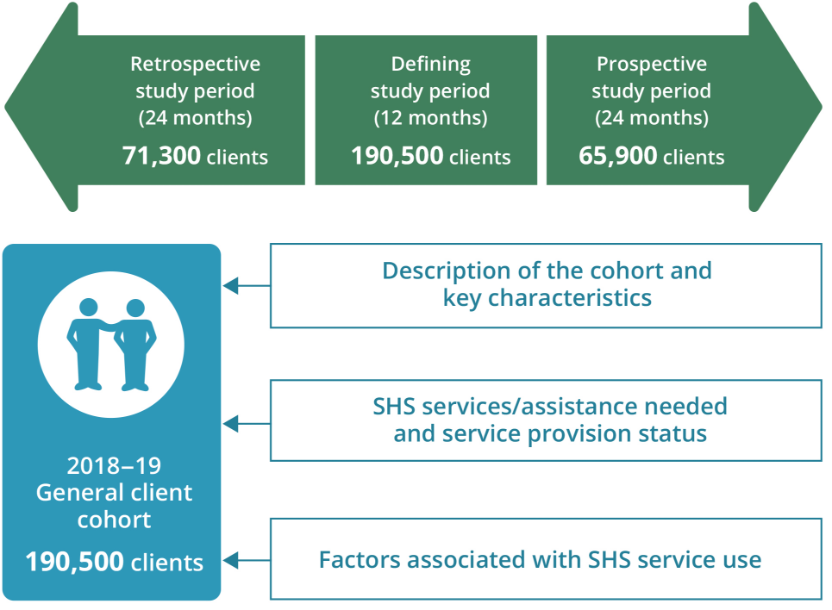
Source: AIHW analysis of SHS longitudinal data 2016–22, Table General1819.1.
Key characteristics of the 2018–19 general cohort
Over 190,500 clients aged 16 and over received SHS services in 2018–19; these clients had the following key characteristics (Figure General1819.2, Table General1819.1, Table General1819.2):
- Nearly half (49% or 92,500 clients) were aged 25 to 44 years.
- Nearly two-thirds (63% or 120,300 clients) were female
- Over 53% (101,800 clients) received only one episode of support in 2018–19.
- Nearly 38% of clients (72,000) experienced FDV.
- Over 37% (71,300 clients) had used SHS services in the 24 months before the defining study period.
- Nearly 35% (65,900 clients) continued to use SHS services after the defining study period (that is, in the 24 months after the defining study period).
- One quarter of clients (46,800) were Indigenous Australians and 17% (32,900 clients) were born overseas.
- Nearly 28% (52,900 clients) received accommodation in the defining study period; a little over half of all clients (52%, 99,100) were homeless at some time.
- Of the 99,100 clients that experienced homelessness, half (50,700 clients) had been couch surfing at some time in the defining period.
- Over 39% (74,400 clients) had mental health issues during the defining study period, and nearly 14% (25,700 clients) had problematic drug or alcohol issues.
- The majority (81%, 154,300 clients) were not employed (that is, unemployed or not in the labour force) at some time during their SHS support in the defining study period.
Figure General 2: General cohort 2018–19, client key characteristics, by study period
This interactive bar chart shows a drop-down list of key characteristics, numbers and percent can be displayed, across all study periods (defining, retrospective and prospective). Data for the individual state/territory and Australia can be selected. For Australia, nearly half (49% or 92,500 clients) were aged 25 to 44 years, nearly two-thirds (63% or 120,300 clients) were female and over 53% (101,800 clients) received only one episode of support in 2018–19.
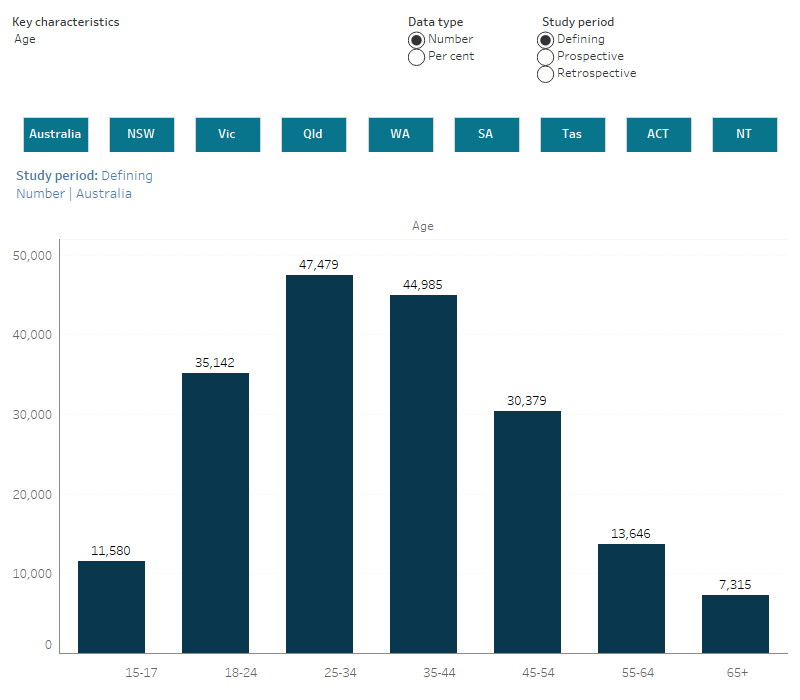
Notes
- Counts of clients with values of No include cases where the variable is not stated or unknown.
- Clients are counted as Indigenous or overseas-born if they are classified as such in any support period in the longitudinal data.
- Percentages are calculated using total clients within the cohort as the denominator (General cohort: 190,526). For the retrospective and prospective study periods the percentages may not add to 100 as not all cohort clients are included in these periods.
- Received accommodation indicates that the client was provided either short-term or emergency accommodation, medium term/transitional housing, or long-term housing.
- Short-term clients received SHS services only during the defining study period. Historical clients received SHS services in the retrospective and defining study periods. Ongoing clients received SHS services in the defining and prospective study periods. Long-term clients, received SHS services in all three study periods.
- Reason refers to the reasons a client presented to any specialist homelessness services agency during the study period.
- The variable Ever Presented Alone refers to whether a client was ever recorded as having presented for support (that is, started a support period) alone. Unlike many other variables, this is only recorded in the SHS data at the start of support periods. Counts of clients with values of No include cases where the variable is not stated or unknown. Note: for children, there may be instances where the child physically presented with an adult to an agency, but only the child required and received SHSC services, or where the child was not correctly linked to the group when the support period was opened.
- The variable Presented with child(ren) indicates whether the client presented for support (that is, started a support period) as part of a group which contained one or more children.
Source: AIHW analysis of SHS longitudinal data 2016–22, Table General1819.1.
Service engagement profiles
SHS support patterns of the 2018–19 general cohort for the period 2016–17 to 2021–22 were examined. Almost half (89,200, 47%) were short-term clients (receiving services only during the 12-month defining study period) (Figure General.3, Table General1819.1, Table General1819.2). Around 19% of the 2018–19 general cohort were long-term clients, that used services both historically and into the future.
Note that the proportions for service engagement profiles for the 2018–19 general cohort will differ to the finding for the 2015–16 general cohort because the retrospective and prospective periods are narrower (24 months compared with 48 months for the 2015–16 cohort).
Short-term clients received SHS services only during the defining study period.
Historical clients received SHS services in the retrospective and defining study periods.
Ongoing clients received SHS services in the defining and prospective study periods.
Long-term clients received SHS services in all three study periods.
Figure General 3: General cohort 2018–19, service engagement profiles
This interactive bar chart shows service use patterns of the 2018–19 general cohort over the longitudinal period (2016–17 to 2021–22). Support information was combined from the discrete study periods into four service engagement profile groups (historical, short-term, long-term and ongoing). Engagement profiles for all states and territories and Australia can be selected and displayed. Nationally, of the 190,500 clients that made up the study period cohort, almost half (89,200, 47%) were short-term clients (receiving services only during the 12-month defining study period). Around 19% of the 2018–19 general cohort were long-term clients, that used services both historically and into the future.
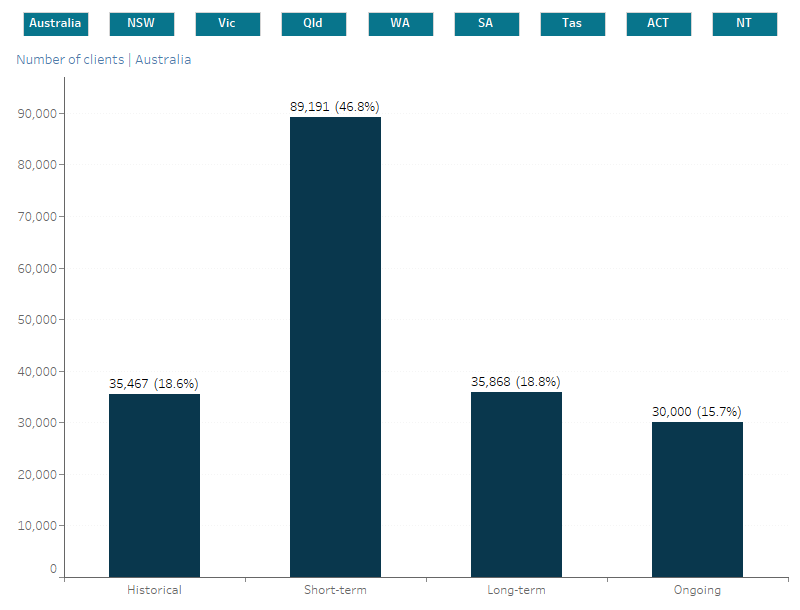
Note: Short-term clients received SHS services only during the defining study period. Historical clients received SHS services in the retrospective and defining study periods. Ongoing clients received SHS services in the defining and prospective study periods. Long-term clients received SHS services in all three study periods.
Source: AIHW analysis of SHS longitudinal data 2016–22, Table General1819.1.
Vulnerability pathways
Using data for the period 2016–17 to 2021–22, client profiles were examined for the presence of vulnerabilities including mental health issues, drug and/or alcohol problems, and experience of family and domestic violence (FDV) within each of the three study periods – the retrospective, defining and prospective periods (Figure General.4, Table General1819.1, Table General1819.3). For more information on the derivation of these vulnerabilities, see Methodology.
Nearly 74,400 clients had a current mental health issue in the defining period. Of these, around 28,700 clients (39%) were not an SHS client in either the retrospective or prospective periods. Around 12% (8,800 clients) were SHS clients and had a current mental health issue in all study periods.
Figure General.4 provides detailed insights into the vulnerability profile for 2018–19 general cohort clients experiencing FDV, clients with a current mental health issue and those with problematic drug/alcohol use.
Figure General 4: General cohort 2018–19, vulnerability pathways
This interactive Sankey diagram shows the 2018–19 general cohort clients who experienced three vulnerabilities, clients who had experienced FDV, clients with a mental health issue and those with problems with drugs or alcohol in the defining study period and whether clients also experienced these vulnerabilities in the past and future study periods. These vulnerability pathways are shown separately, using radio buttons to select between vulnerability types. Using data for the entire longitudinal period (2016–17 to 2021–22), 2018–19 general cohort clients were assessed for the presence of these vulnerabilities within each of the three study periods – the retrospective, defining and prospective periods. Vulnerability data and pathways for all states and territories and Australia can be selected and displayed. Nearly 74,400 clients had a current mental health issue in the defining period. Of these, around 28,700 clients (39%) were not an SHS client in either the retrospective or prospective periods. Around 12% (8,800 clients) were SHS clients and had a current mental health issue in all study periods.
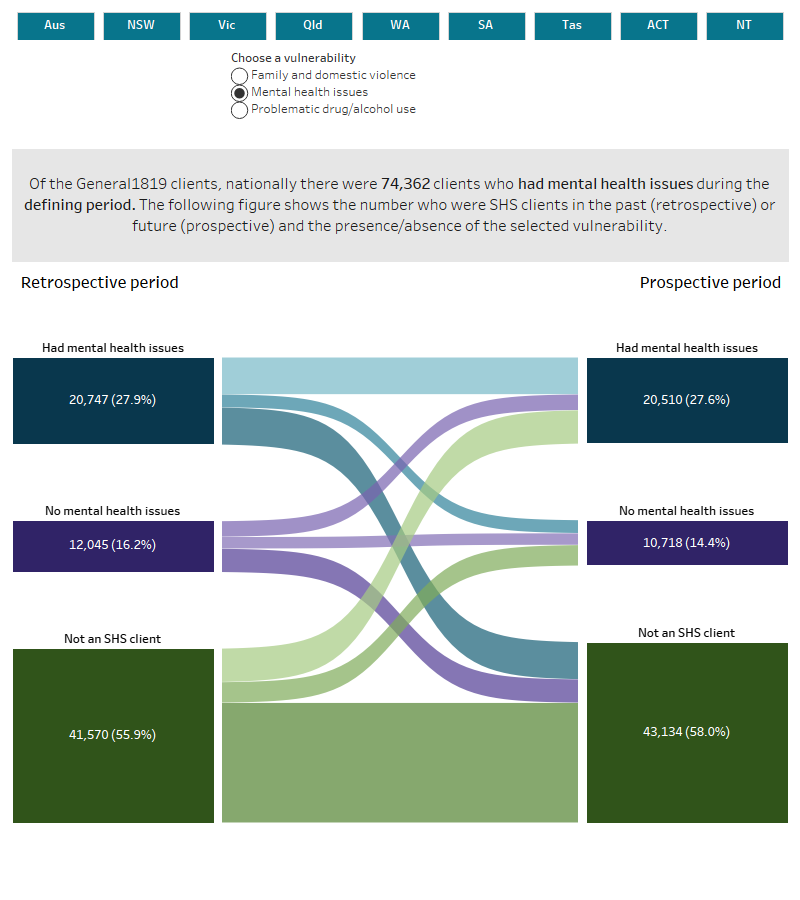
Notes
- Percentages are calculated using total clients who experienced the selected vulnerability in the defining period as the denominator (74,362).
- The defining study period covered 12 months from the first day of their first support period during 2018–19. The retrospective period for this cohort was 24 months (that is, the 24 months before the first day of the client’s first support period in 2018–19). The prospective study period for each client ranged for the 24 months after the defining period ended.
Source: AIHW analysis of SHS longitudinal data 2016–22, Table General1819.3.
SHS services needed by 2018–19 general cohort clients
The need for, and provision/referral of, SHS services was examined for clients in the retrospective, defining and prospective study periods; aggregation is based on services needed or provided/referred in support periods that commenced within each study period only.
Patterns of service need were generally similar for the clients across the three study periods (Figure General.5, Table General1819.1, Table General1819.4). For example, the proportion of clients with a need for accommodation assistance (any form) ranged from 73% in the defining to 78% in the prospective period and 77% in the retrospective period. Typically, clients needed long-term housing (needed by 43% of clients in the defining period) or short-term housing (needed by 43% of clients in the defining period).
Figure General 5: General cohort 2018–19, select top 10 services and assistance needed and service provision status by study period
The interactive stacked horizontal bar graph shows the select top 10 services needed and the provision/referral status for the 2018–19 general cohort clients (190,500 clients) that used services in the retrospective, defining and prospective study periods. Patterns of service need were generally similar for the clients across the three study periods. For example, the proportion of clients with a need for accommodation assistance (any form) ranged from 73% in the defining to 78% in the prospective period and 77% in the retrospective period. Typically, clients needed long-term housing (needed by 43% of clients in the defining period) or short-term housing (needed by 43% of clients in the defining period).
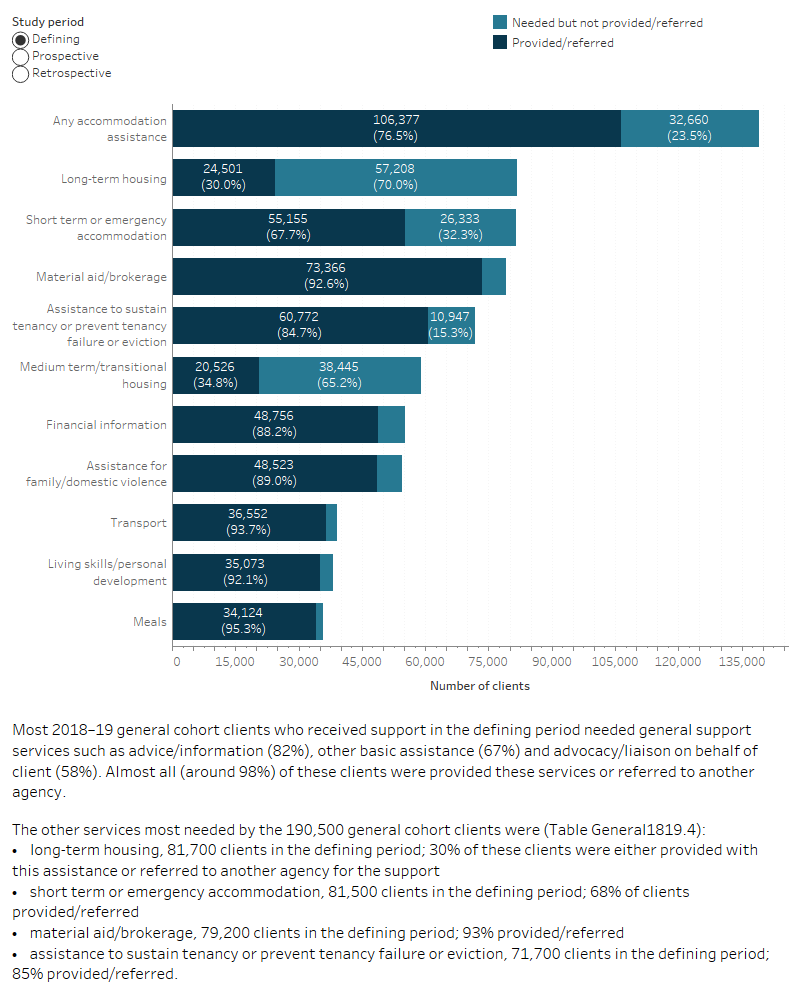
Notes
- Percentages are based on the number of clients who needed the service in each study period as the denominator.
- Any accommodation assistance refers to need or provision of any of short-term or emergency accommodation, medium term/transitional housing, long-term housing, assistance to sustain tenancy or prevent tenancy failure or eviction, assistance to prevent foreclosures or for mortgage arrears.
- The services Other basic assistance, Advice/information and Advocacy/liaison on behalf of client have not been included in the top 10 shown above.
Source: AIHW analysis of SHS longitudinal data 2016–22, Table General1819.4.
Factors associated with SHS service use
Descriptive regression models were used to examine whether client characteristics or support experience in the defining period were associated with receiving SHS support in the prospective study period (ongoing service use). Information on interpreting regression models can be found in the section Understanding factors associated with past and future support. Two models were created; a ‘client characteristic’ model (Model 1) that contained client characteristics and a ‘reasons’ model (Model 2) that supplemented these characteristics with the 26 reasons why the client sought support during the defining study period. Multiple regression is used, which in this case means that the effect of each variable is measured while keeping the effects of all other variables in the model constant.
Variations in state and territory specific policies and service delivery models mean that the likelihood of a client receiving services in the future varied among states and territories. Therefore, in addition to a national model, separate regression models were created for each state or territory where there was sufficient sample size (at least 3,500 clients; Table General1819.1). The models are descriptive, that is, they are intended to describe the client variables that are associated with past or future service use without proposing or testing specific causal pathways.
The outcome variable (receipt of SHS support) was a binary measure (yes or no) and did not distinguish between clients that needed SHS services only once in the prospective study period and clients that required frequent support.
Risk ratios were created to measure the association between the use of SHS services and a set of client characteristics (see Glossary entry on Relative Risk for how to interpret the results)
Some bias is present in this outcome measure because some clients who required services in the future may not have been able to receive them (see the section on Bias within the SHSC longitudinal data).
The results from the client characteristic model (Model 1) demonstrates that although different in magnitude in each state or territory, the characteristics in the defining period that had the greatest association with future SHS support when all other factors are taken into consideration were (Figure General.6, Table General1819.5):
- having transitioned from custody (39% greater likelihood)
- not been employed at some time while receiving support in the defining study period (39% greater)
- being Indigenous (35%). This is partly due to the difficult social and economic circumstances faced by some Indigenous Australians and a higher prevalence of health risk factors (POA 2004, AIHW 2020)
- starting a period of support in public or community housing, and ending that period of support in a different housing situation (26% greater)
- having been homeless (26% greater)
- having had problematic drug or alcohol issues in the defining study period (25% greater).
Factors associated with a reduced likelihood of using services in the future included having owned a home sometime in the defining study period (20% lower likelihood) and having ended a support period in public or community housing (having started a support period elsewhere) (during the defining study period, 15% lower).
The reasons model (Model 2; Figure General.6, Table General1819.5) demonstrates that, in addition to similar associations as shown in Model 1, having financial difficulties as a reason for seeking assistance, or being itinerant as a reason, were associated with an increased likelihood of ongoing SHS support (19% and 22% greater likelihood respectively nationally). Nationally, clients whose reason was transition from custodial arrangements were 26% more likely to receive SHS support into the future.
Associations for service use in the past (retrospective period) were similar, with starting support in public or community housing and ending elsewhere showing the strongest association (30% greater) and having transitioned from custody, having not been employed, and having problematic drug or alcohol issues (all 23% greater). Owning a home reduced the association by 30%.
Figure General 6: Relative risk for use of SHS services (General cohort 2018–19)
The interactive risk ratio plot shows the characteristics or reasons for presenting that are associated with the 2018–19 general cohort clients’ use of SHS services in the past (retrospective) or future (prospective period), these associations are presented as relative risks. Relative risks for all states and territories and Australia can be selected and displayed. Two regression models can be selected, Model 1 contains client characteristics and experiences in the defining period, Model 2 contains client characteristics and the reasons for seeking support in the defining study period. For both past and future SHS support the associations were similar. Nationally, being either unemployed or not in the labour force at some time during the defining study period had the strongest association with past or future SHS support. Having transitioned from custody and being Indigenous were associated with an increased likelihood of past or future support.
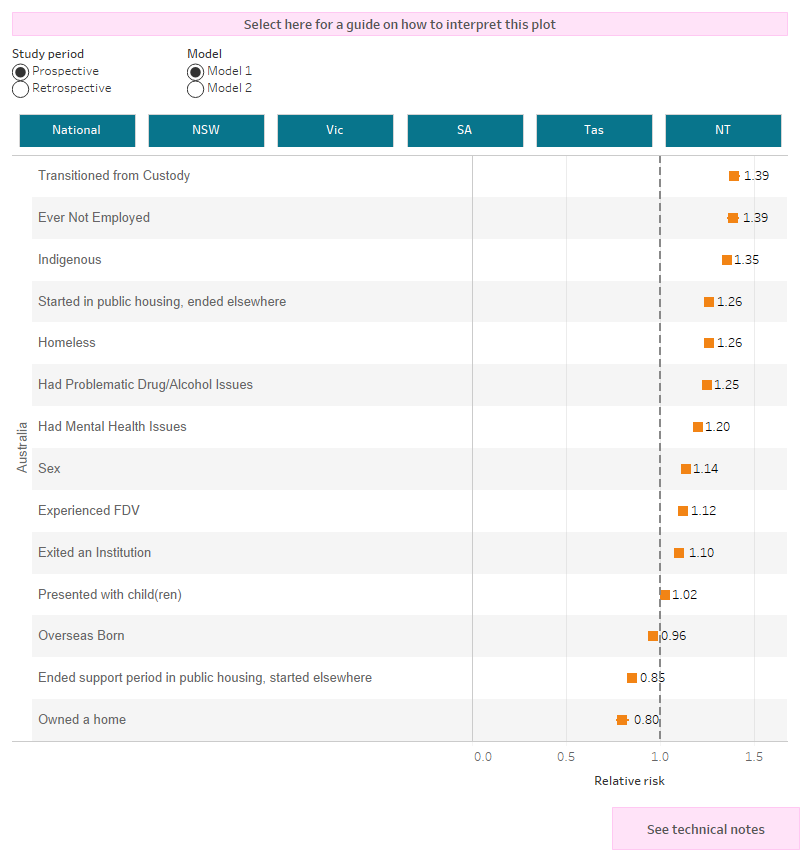
Notes
Apart from overseas-born and Indigenous, all other parameters capture whether a client ever experienced that situation in the defining period (for example, homeless captures whether the client was homeless at any time during a support period in the defining study period).
Not employed means unemployed or not in the labour force.
Presented with child(ren) means that the client started at least one support period in the defining study period with one or more children.
Model 1 contains client characteristics and experiences in the defining period, Model 2 contains client characteristics and also the reasons for seeking support in the defining study period.
Source: AIHW analysis of SHS longitudinal data 2016–22, Table General1819.5.
Summary
Over 190,500 clients aged 16 and over received SHS services in 2018–19. Two-third were female, one quarter were Indigenous, and nearly 40% had mental health issues reported during the defining study period.
Around one third of clients used services in the previous two years, and one third of clients continued to use services in the following two years. Note, this is relatively smaller than the proportion of retrospective and prospective clients in the cohort of clients in 2015–16 studied earlier (44% for both periods) because the retrospective and prospective study periods are narrower for the 2018–19 cohort (24 months versus 48 months). Similarly, the 2018–19 cohort has more short-term clients (47%) compared with the 2015–16 cohort (39%).
Around three-quarters of clients sought accommodation assistance in the defining study period.
The factors most associated with ongoing use of SHS into the prospective study period include having transitioned from custody and having not been employed at some time while receiving support in the defining study period.
Australian Institute of Health and Welfare (AIHW) (2021) Specialist homelessness services annual report 2020–21, AIHW, Canberra.
AIHW (2020) Health risk factors among Indigenous Australians. Australia's health 2020: snapshots. Australia’s health series no. 17 Canberra: AIHW.
POA (Parliament of Australia) (2004) A hand up not a hand out: Renewing the fight against poverty. Report on Poverty and Financial Hardship. Canberra: Senate Community Affairs Reference Committee.


